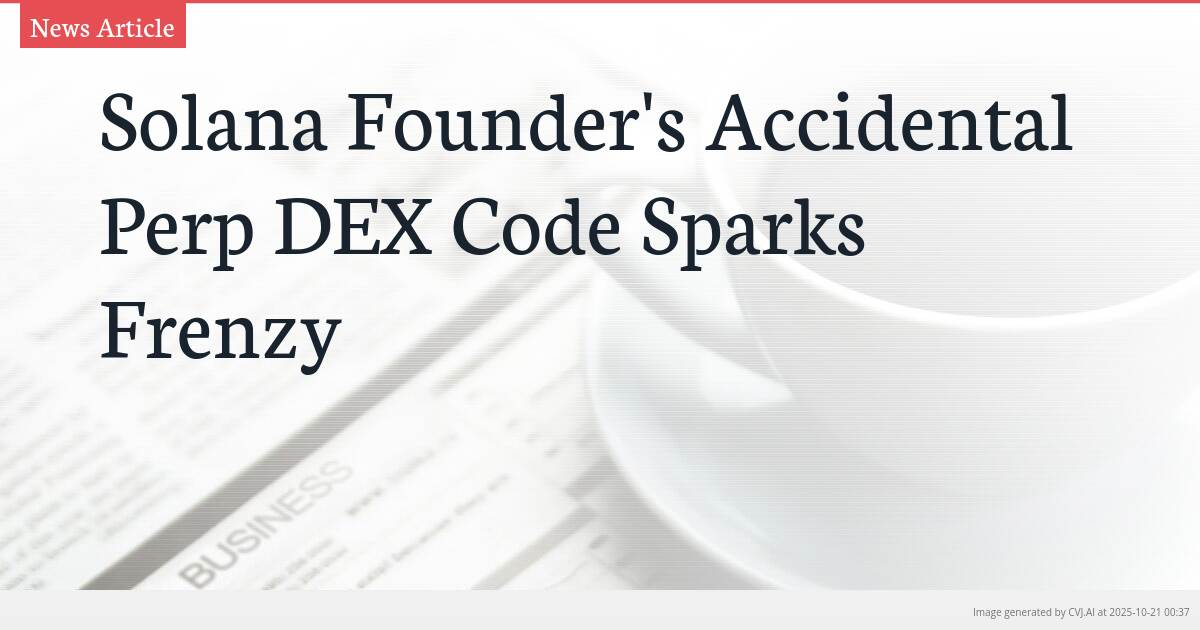Introduction
Solana founder Anatoly Yakovenko accidentally published code for a perpetual futures exchange on GitHub, triggering massive speculation about a potential Hyperliquid competitor and igniting a $6.23 million meme coin frenzy. While Yakovenko clarified he was merely experimenting with AI tools and never intended to develop the platform, the incident revealed the intense market appetite for new perpetual futures trading venues on the Solana network.
Key Points
- Yakovenko's 'Percolator' exchange code was implementation-ready and designed as a self-custodial sharded exchange before being revealed as an AI experiment
- The incident triggered a Solana meme coin that briefly reached $6.23 million market capitalization before crashing 79% following Yakovenko's clarification
- Perp DEX competition is intensifying with platforms like Aster offering 1,001x leverage on Bitcoin versus Hyperliquid's 40x, raising systemic risk concerns
The Accidental Code That Shook Crypto Markets
Solana founder Anatoly Yakovenko’s casual experimentation with AI tools unexpectedly sent ripples through the cryptocurrency world when code for a perpetual futures exchange called ‘Percolator’ appeared on GitHub. The implementation-ready code described a self-custodial ‘sharded’ exchange that appeared poised to challenge established perpetual futures platforms. The discovery immediately sparked speculation that Solana might be getting its own Hyperliquid competitor, sending crypto communities into a frenzy of anticipation.
Yakovenko quickly clarified the situation, explaining he was ‘messing around’ with the AI tool Claude and had made the repository public by accident. Despite his insistence that this was merely an experimental project with no development plans, the market reaction was immediate and substantial. ‘Make one repo public on accident and the whole world goes nuts,’ Yakovenko posted on X in response to the overwhelming attention his accidental upload generated.
Meme Coin Mania and Degen Speculation
The speculation around Yakovenko’s accidental code release manifested in classic crypto fashion through a Solana meme coin named after the GitHub project. The token soared to a staggering $6.23 million market capitalization as traders bet on the potential of a Solana-founder-backed perpetual futures exchange. This speculative mania occurred despite Yakovenko’s clear statements that he had no intention of developing the platform himself.
Following Yakovenko’s pushback and clarification that the code was merely an AI experiment, the meme coin experienced a dramatic 79% crash, settling at a market capitalization of $1.28 million. The episode demonstrated the powerful influence that Solana founders’ actions—even accidental ones—can have on market behavior. Helius Labs founder Mert Mumtaz captured the community sentiment, writing on X: ‘If your chain founder isn’t vibe coding perps DEXs on the side, it’s time to look for a new chain.’
The Intensifying Perpetual Futures Arms Race
The intense reaction to Yakovenko’s code leak underscores the booming business of perpetual futures in cryptocurrency markets. These derivatives contracts allow traders to take long or short positions on assets without owning the underlying cryptocurrency, with leverage becoming a key competitive differentiator among exchanges. The current landscape is dominated by platforms like Hyperliquid, with newer competitors including Avantis and Aster entering the fray.
The competition has escalated into a leverage arms race, with Aster now offering a staggering 1,001x leverage on Bitcoin compared to Hyperliquid’s 40x limit. While Aster operates across multiple networks, its strongest presence is on the Binance-connected BNB Chain, where it has periodically challenged Hyperliquid in trading volume and revenue. Despite existing Solana perpetual futures DEXs, none have yet reached the scale of Hyperliquid or Aster, explaining the excitement around Yakovenko’s potential entry.
This leverage competition comes with significant risks, as demonstrated by the recent $19 billion liquidation event—the largest in crypto history—where leveraged positions were wiped out in under 24 hours. Experts warned that this liquidation cascade was exacerbated by high leverage levels, suggesting such events may become more common as perpetual futures DEXs proliferate. Despite these concerns, exchange operators argue they’re simply meeting trader demand for higher leverage products.
Open Invitation for Solana Development
Rather than developing Percolator himself, Yakovenko has openly encouraged other developers to ‘steal the idea’ and build upon his accidental code release. This invitation highlights the Solana ecosystem’s desire for stronger perpetual futures trading capabilities to compete with established platforms on other networks. The incident reveals both the community’s hunger for native Solana solutions and the network’s potential to host sophisticated DeFi infrastructure.
The episode also demonstrates how AI tools like Claude are becoming integrated into cryptocurrency development workflows, even for high-profile founders experimenting with complex financial products. While Yakovenko’s perpetual futures exchange may never materialize, the market reaction and subsequent developer interest suggest the Solana ecosystem remains ripe for innovation in derivatives trading, particularly as the network continues to attract development talent and user attention.
📎 Source reference: decrypt.co

